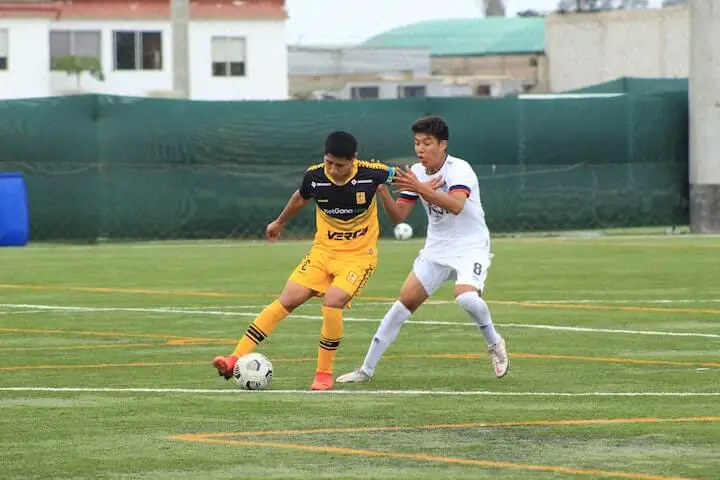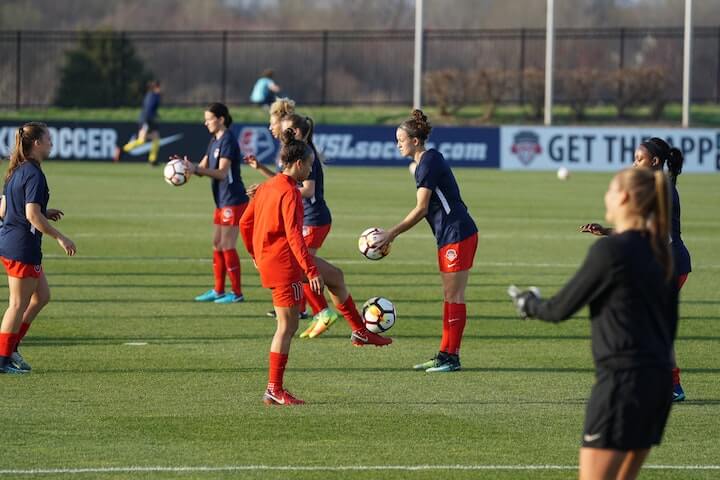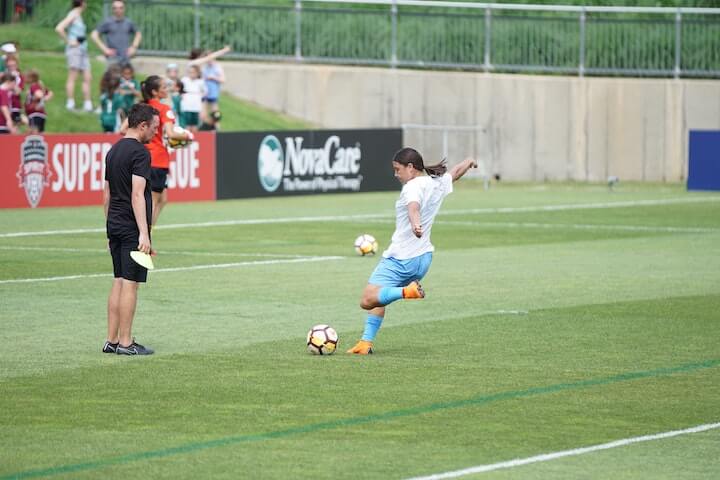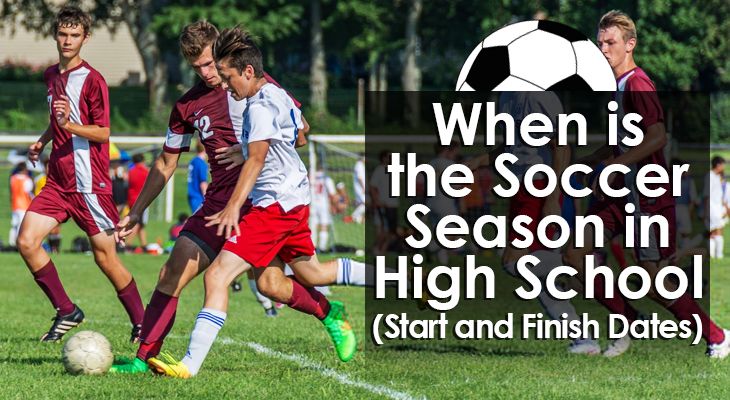When is the Soccer Season in High School? (Start and Finish)
For many high school students, the soccer season is the highlight of their school year.
> After-school practices...
> Early morning conditioning...
> And of course playing actual matches...
This is a period in life that every player should treasure!
Whether you’re a serious athlete or a casual high school player, it’s important to know when the soccer season starts and finishes. This helps ensure you have adequate time to prepare, get in shape, and find a healthy balance between sports and academics.
So, when is the soccer season in high school?
Read on to find out.
When is the Soccer Season in High School?
In most states, soccer is considered a fall sport.
The season kicks off as soon as kids return to high school and typically ends in December, right as winter begins to set in.
Since soccer is an outdoor sport, played predominantly on the ground, it's optimal to play in mild conditions -- for the fields, the players, the flow of the game, and the spectators.
That said, the timing and organization of the high school soccer season are the responsibility of the high school athletics associations of each state.
So, there may be slight differences in schedules between states or districts.

Fall Leagues
High school fall soccer leagues usually begin within the first few weeks of the school year.
Depending on the school district, this can be as early as mid-August or as late as the end of September to the beginning of October.
The first day of school varies from location to location but typically starts right after Labor Day.
Schools participating in fall leagues usually start training immediately when school returns.
Some schools may even run off-season practices or tryouts to ensure their teams are prepared once the competitive games kick-off.
The first round of games usually start around mid-September and regular matches continue weekly until the end of November or the beginning of December.
At this point, depending on the tournament format, leagues either crown the champions or being their playoffs for the top teams.
While there may be slight scheduling discrepancies between locations, fall seasons are always concluded before the December holidays or the turning of the year.
Winter Leagues
Due to the sheer size of the United States, the weather may vary significantly from state to state.
This is particularly apparent when comparing the northern and southern states.
Therefore, in some regions, winter leagues are more common, as the conditions are more suited to outdoor play.
Winter leagues usually start when fall leagues end: in November or December.
They run through the new year and finish up in February or March.
Spring Leagues
Spring leagues aren’t very common in competitive high school soccer.
The main reasons for this are that they would clash with other sports and may also create conflicts with the end-of-year academic schedule.
Also, regional competitions for club soccer usually take place during spring, so fixture congestion and availability of facilities can also become issues.
However, many schools host recreational games, development leagues, or tournaments during this season. But these types of competitions are not necessarily cemented into the calendar.
In regions that run spring high school leagues, the season usually starts in early March and runs through May or into early June.
This gives players enough time to compete and switch their focus to their studies before the end of the academic year.
Summer League
Since schools aren't open during summer, there are no competitive high school leagues during this period.
However, high-level teams often train during the off-season and may even play in “friendly” games or summer tournaments.
Some high school players use the summer holidays to rest and recover but many spend their off-season participating in ID camps or playing recreational soccer.
Summer is an excellent opportunity for players to work on their individual weaknesses and improve their overall game ahead of a new season.
High School National Championships
In contrast to college or club soccer, high school sports don’t usually progress past state championships.
There are no recognized regional or national competitions for high school soccer teams.
One of the main reasons for this is the irregular structure of the competitive seasons.
As mentioned, depending on the location, the seasons run at different times. This makes it very difficult for sports authorities to arrange national competitions that suit schools from all states.
Secondly, traveling can be a major obstacle for high school teams.
Without significant funding or sponsorships, the cost of taking teams on the road each year is simply too high.
However, some high school teams get opportunities to play out of state or even compete internationally if their schools have a certain prestige, a lot of funding, or partner with other schools in different countries.

Factors That Determine the HS Soccer Season
Since high schools don’t share the same start and finish dates, it’s easy to understand why all competitive leagues don’t run at the exact same times.
However, you might be wondering WHY there is such a discrepancy between certain districts, and why some operate in the fall while others run during winter.
There are several factors that influence when the high school soccer season takes place.
#1 - Weather
The weather is the biggest factor in determining the start and end of high school soccer seasons.
Combining all 50 states, the U.S. consists of over 3.79 million square miles of land mass.
So depending on where you are in the country, the weather can be dramatically different.
However, for the majority of states, the fall months tend to be the most suitable for soccer.
After a dry summer, the fields are in good condition.
What’s more, the temperatures begin to cool from August or September onward, making for pleasant playing conditions.
Nonetheless, this isn’t necessarily the case for every state.
Some southern regions, for example, get ferociously hot during summer and temperatures may not dip off significantly until winter.
#2 - Popularity of the Sport
In particular parts of the country, certain sports are totally dominant.
Therefore, the most popular sport takes precedence when organizing the sports schedule.
If soccer isn’t among the primary sports in the region, leagues may structure their season to accommodate the more important (or bigger) leagues.
For example, the football season typically runs during the fall.
If the football and soccer seasons overlap, soccer is the sport most likely to have to adjust. This is especially true when sports teams share facilities, like fields, locker rooms, and gyms.
#3 - Availability of Facilities
It’s very common for multi-sport high schools to have shared facilities among sports teams.
For these instances, it’s simply not viable to have multiple fields, gyms, locker rooms, and other amenities for each individual team.
State athletics associations take such factors into consideration when setting out the annual sporting calendar and try to create a balance that suits all parties.
When it comes to state championships, the events are often held at large sports grounds where teams can play multiple games at the same time.
These events usually take place over the course of several days.
Again, state athletics associations must coordinate sports calendars to ensure these facilities are available when needed at various stages throughout the year.
#4 - Traditions
Some high school seasons run at the same time each year because of tradition.
Rather than make adjustments to the sporting calendar each year, sports authorities choose to keep schedules the same year-on-year.
While this makes the seasons easy to follow, it isn’t always the best approach, especially for a flourishing sport like soccer.
If soccer was traditionally seen as a less popular game, the season may not be run at an optimal time, like the fall.
#5 - Regional Sports Scene
In some states, like California, New York, Washington, and Florida, soccer is one of the most popular and fastest-growing sports.
It's not only played in schools, but also at club level.
This can also influence when the high school season runs.
Most club regional soccer leagues take place in the fall, with the winners progressing to the regionals in the spring, and the nationals during summer.

Main Exceptions to the Regular Season
Three U.S. states go totally against the grain when it comes to the high school regular season:
- California
- Texas
- Florida
Due to their size and location, these states operate on their own unique schedules.
Here’s the breakdown:
a. California
In California, the CIF (California Interscholastic Federation) arranges the HS soccer season.
They schedule the season uniquely from November until March.
This arrangement aligns perfectly with the club season, which usually runs through fall.
It also ensures that teams play games in favorable weather conditions, with California having some of the best weather in the country.
However, it can get very hot during summer. The winter schedule means mild conditions during matches, which are optimal for outdoor soccer.
Once the high school season finishes, the club regionals begin, ensuring both seasons conveniently intertwine.
b. Texas
Texas is an American football region by tradition.
Although soccer has grown immensely in the Lone Star State, it plays second fiddle to the more dominant sports.
Soccer is considered a winter sport in Texas, which makes sense considering the warm climate.
The regular season starts in January and finishes up in April with the state finals.
So in reality, the Texas soccer schedule is a winter and spring season.
c. Florida
In Florida, they follow a winter season that lasts from November until the end of January.
This ensures it doesn’t interfere directly with the football schedule.
It also means that players aren’t forced to compete in the spring and summer heat and humidity.
When the regular season finishes up, teams get a rest period of approximately one month before the state championships take place at the beginning of March.
Length of the High School Soccer Season
The length of the high school soccer season varies depending on the state and may run a little longer or shorter from year to year.
However, a regular season usually lasts around four months.
Teams normally compete in a league structure to determine the seeding for the playoffs or state championships.
Schools are typically put in designated leagues according to their location and level.
So, the top teams compete in one division while the weaker sides play in lower tiers.
While teams often get trophies for finishing at the top of their respective leagues, playoffs or state championships decide who the real champions are.
State championships typically take place over a two or three-day period and are often held on neutral grounds, like college facilities or state athletic grounds.
After crowning the state champions, the high school season is over for another year.
Conclusion
So, if you were wondering when the soccer season in high school starts and ends, the answer isn’t as straightforward as you might think.
Unless you live in California, Florida, or Texas, the likelihood is that you’ll participate in a fall league, running from August or September until November or December.
The beautiful game has become a well-loved sport across America and is trending to rival the likes of American football and basketball in the coming years.

